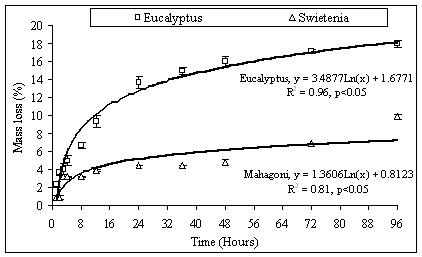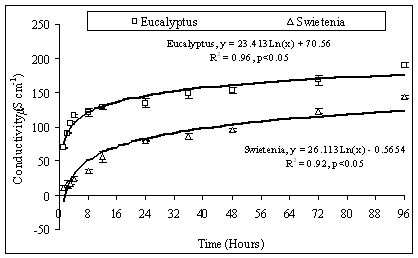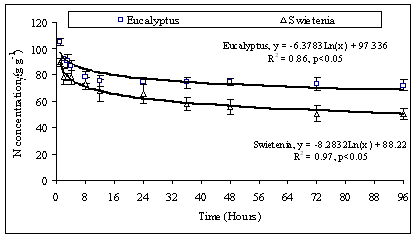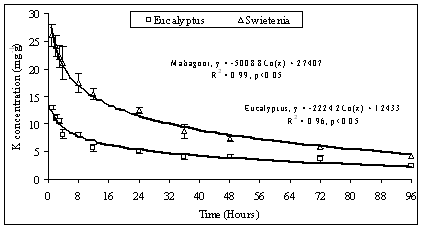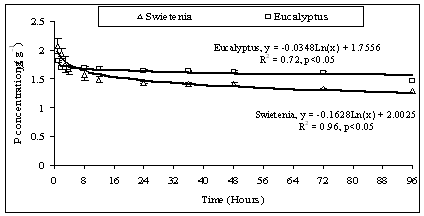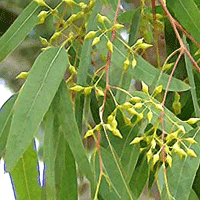
Nutrients (N, P and K) dynamics associated with the leaf litter of two agroforestry tree species of Bangladesh
iForest - Biogeosciences and Forestry, Volume 2, Issue 5, Pages 183-186 (2009)
doi: https://doi.org/10.3832/ifor0510-002
Published: Oct 15, 2009 - Copyright © 2009 SISEF
Research Articles
Abstract
Eucalyptus camaldulensis (Dehnh.) and Swietenia macrophylla (King.) are not native to Bangladesh, but they are widely used in agroforestry practices for their commercial values. Selection of tree species with efficient return of nutrients is a vital challenge in agroforestry practices to maintain the soil fertility for sustainable crop production. Therefore, a comparative study was conducted on nutrients (N, P and K) leaching from leaf litter of E. camaldulensis and S. macrophylla in laboratory condition. The initial dry weight of leaf litter of E. camaldulensis and S. macrophylla were significantly (p<0.05) decreased to 18% and 10%, respectively at the end of the experiment. Eucalyptus camaldulensis showed comparatively (t-test, p<0.05) higher rate of weight loss, conductivity and TDS (Total Dissolved Solid) of leached water. Comparatively, higher amount of N (48 μg g-1) was released from leaf litter of E. camaldulensis whereas higher amount of P (0.8 µg g-1) and K (23 mg g-1) from S. macrophylla, leaf litter and both the species showed similar pattern of nutrient (K>N>P) release during the leaching process. Nutrients (N, P and K) concentration in leaf litter of these species showed significant (p<0.05) negative exponential curvilinear relationships with the weight loss. Result of this study suggests that E. camaldulensis is the best in terms of N return and S. macrophylla the best in terms of P and K return.
Keywords
Introduction
Chemical fertilizer is now commonly used in agricultural practices, but it becomes expensive and farmers are reducing its use due to negative environmental impacts ([3]). In addition, access to fertilizer in developing nations is limited ([18]). It is an important task to gain a better understanding how agricultural practices can be designed with low input of fertilizer. Maintenance of soil productivity is a critical issue in a tropical agroecosystems. Agroforestry practice is an important component of it. Tropical farmers use this practice for their dependence on organic residues as low cost and readily available nutrients for soil fertility management ([13], [8]). To this regard, agroforestry got special impetus in tropical agriculture.
Farmers of the tropical region traditionally use variety of species composition in agroforestry practices. In Bangladesh, leguminous tree species are traditionally used in different agroforestry practices. Presently, farmers prefer Eucalyptus camaldulensis and Swietenia macrophylla due to their commercial values. Agroforestry being a people oriented program, farmer’s preference should be acknowledged, but the performance of these species is needed to be scientifically assessed with due attention in terms of nutrient return efficiency for further promotion. However, nutrient return from a tree is influenced by quantity, quality (nutrient composition) and rate of leaching and decomposition of plant litter ([19], [8]). Leaf litter is the main and quick source of nutrient return to the soil compared to other litter components ([22], [25], [10], [2], [16]). The present study aimed to assess the pattern of nutrients leaching (N, P and K) from the leaf litter of E. camaldulensis and S. macrophylla in laboratory condition.
Materials and Methods
Leaf litter selection and leaching experiment
Bulk of yellowish senescent leaves of E. camaldulensis and S. macrophylla were collected during March 2007 (maximum leaf fall period). This period corresponds to dry season and no leaching was occurred from litter. Litter was air-dried at room temperature for one week. For each species, air-dried leaves were thoroughly mixed and weighted to two grams as an individual sample and thus a total of 42 samples were prepared. Each sample was placed at room temperature into individual beaker (500 ml) and 250 ml of distilled water was poured to each beaker and few drops of HgCl2 solution (50 mg l-1 - [11], [15]) were added in each beaker to prevent fungal decay. Five samples were kept into an oven at 80 °C until constant weight to get the air-dry to oven-dry conversion weight.
Sample collection and measurements
Three replicates of samples were collected at 0, 1, 2, 3, 4, 8, 12, 24, 36, 48, 72 and 96 hours of intervals and the collected samples were ringed by distilled water and oven-dried at 80 °C to constant weight. The mass loss (%) due to the leaching process was calculated from the differences between initial and final oven-dried weights and was expressed as a percentage of initial loss. The rate of mass loss was obtained by dividing mass loss (%) with the leaching time. Conductivity (μS cm-1), total dissolve solid (TDS - mg l-1) of leaching water sample were measured by a conductivity and TDS meter manufactured by Ciba-Corning Diagnostic Ltd., England.
Nutrients measurement in leaf litter
The leaf samples were processed and acid digested according to Allen ([1]). Nitrogen (N) and phosphorus (P) concentration in sample extracts were measured according to Weatherburm ([23]) and Timothy et al. ([21]), respectively using UV-Visible Recording Spectrophotometer (Shimadzu UV-160A, Japan). Potassium concentration in leaf extracts at different time intervals were measured by Atomic Absorption Spectrophotometer (Perkin Elmer 4100, USA). The nutrient amounts released from leaf litters were calculated as differences between initial and final absolute amounts and also expressed as percentage of initial amounts.
Statistical analysis
The rate of mass loss and nutrients (N, P and K) concentration in leaf litter of each species at different time intervals was compared by one way analysis of variance using SAS 6.12 statistical software. Rate of mass loss, conductivity, TDS and nutrients (N, P and K) concentration in leaf litter between two species were compared by unpaired t-test using SPSS (11.5) Statistical Software. For each species relationships among the mass loss and nutrients (N, P and K) concentration with leaching time were calculated.
Results
The initial dry mass of leaf litter of E. camaldulensis and S. macrophylla were significantly (p<0.05) decreased to 13.6% and 4.37% after 24 hours; 18% and 10%, after 96 hours respectively (Fig. 1) and comparatively (t-test, p<0.05) higher rate of mass loss was observed for E. camaldulensis (Fig. 2). Conductivity and TDS of leaching water of both the species were significantly (p<0.05) increased at the end of the experiment and comparatively (t-test, p<0.05) higher conductivity and TDS were observed for E. camaldulensis (Fig. 3, Fig. 4). Mass loss of leaf litter, conductivity and TDS of leaching water of both the species showed significant (p<0.05) positive logarithmic relationships with the leaching time (Fig. 1, Fig. 3, Fig. 4).
Fig. 1 - Mass loss (%) of leaf litter of Eucalyptus camaldulensis and Swietenia macrophylla at different time intervals.
Fig. 2 - Mass loss rate (% h-1) of leaf litter of Eucalyptus camaldulensis and Swietenia macrophylla at different time intervals.
Fig. 3 - Conductivity (µS cm-1) in leaching water samples of Eucalyptus camaldulensis and Swietenia macrophylla at different time intervals.
Fig. 4 - Total dissolve solid (mg l-1) in leaching water samples of Eucalyptus camaldulensis and Swietenia macrophylla at different time intervals.
Initial concentrations of N, P and K in leaf litter of E. camaldulensis were significantly (p<0.05) decreased from 120 μg g-1, 2.15 μg g-1, and 21.76 mg g-1 to 75.09 μg g-1, 1.65 μg g-1 and 5.14 mg g-1, respectively after 24 hours. Similarly, N, P, and K concentration in leaf litter of S. macrophylla were significantly (p<0.05) decreased from 90.98 μg g-1, 2.09 μg g-1, and 27.75 mg g-1 to 65.51 μg g-1, 1.43 μg g-1 and 12.5 mg g-1, respectively after 24 hours (Fig. 5, Fig. 7). And after 96 hours, 40%, 32% and 89% of the initial amount of N, P and K was lost for E. camaldulensis, whereas 43%, 38% and 85% for S macrophylla (Tab. 1).
Fig. 5 - Nitrogen concentration (μg g-1) in leaf litter of Eucalyptus camaldulensis and Swietenia macrophylla at different time intervals.
Fig. 7 - Potassium concentration (mg g-1) in leaf litter of Eucalyptus camaldulensis and Swietenia macrophylla at different time intervals.
Tab. 1 - Absolute amount of nutrients released from leaf litter during the leaching process. Values in the parenthesis indicate released nutrient amounts expressed as percentage of initial nutrient amount.
| Species | Nitrogen (μg g-1) |
Phosphorus (μg g-1) |
Potassium (mg g-1) |
|---|---|---|---|
| E. camaldulensis | 48 (40) |
0.70 (32) |
19.26 (89) |
| S. macrophylla | 40 (43) |
0.80 (38) |
23.42 (85) |
Comparatively (t-test, p<0.05) higher concentrations of N was observed in leaf litter of E. camaldulensis (Fig. 5), whereas higher concentrations of K was observed in S. macrophylla (Fig. 7) throughout the leaching process, but these species contained similar (t-test, p > 0.05) concentration of P (Fig. 6). Higher amount of N (48 μg g-1) was released from leaf litter of E. camaldulensis whereas higher amount of P (0.8 µg g-1) and K (23 mg g-1) was released from S. macrophylla and both the species showed similar pattern of nutrient (K>N>P) release during the leaching process (Tab. 1). Nutrients (N, P and K) concentration in leaf litter of these species showed significant (p<0.05) negative logarithmic relationships with the mass loss (Tab. 2).
Fig. 6 - Phosphorus concentration (μg g-1) in leaf litter of Eucalyptus camaldulensis and Swietenia macrophylla at different time intervals.
Tab. 2 - Relationships among the mass loss and nutrients concentration of leaf litter throughout the leaching experiment.
| Species | Negative exponential curvilinear relationships among mass loss and nutrients |
||
|---|---|---|---|
| N | P | K | |
| E. camaldulensis | Y = -6.3783Ln(x) + 97.34, R2 = 0.86 |
Y = -0.0348Ln(x) + 1.7556, R2 = 0.72 |
Y = -2224.2Ln(x) + 12433, R2 = 0.96 |
| S. macrophylla | Y = -8.2832Ln(x) + 88.22, R2 = 0.97 |
Y = -0.1628Ln(x) + 2.0025, R2 = 0.86 |
Y = -5008.8Ln(x) + 24407 R2 = 0.86 |
Discussion
Significant positive logarithmic relationships among the leaching time and mass loss, conductivity and TDS (Fig. 1, Fig. 3, and Fig. 4) indicate that water soluble organic and inorganic substances are leached from leaf litter, and ceased with the increasing leaching time. Park & Hyun ([16]), Kongkon et al. ([7]) and Hasan et al. ([4]) reported similar relationships among leaching time and mass loss of leaf litter, conductivity and TDS of leaching water. The higher rate of mass loss up to eight hours (Fig. 2) may be due to initial rapid loss of soluble inorganic and organic substances ([22]). The average rate of mass loss of E. camaldulensis and S. macrophylla leaf litter of the present study were 0.92% hr-1 and 0.41% hr-1, respectively, which were higher than Acacia auriculiformis (0.25% hr-1), Vitex madiensis (0.25% hr-1), Syzygium guineese var. guineese (0.03% hr-1 - [7], [6]) and lower than Melia azedarach (1.15% hr-1 - [4]). The observed differences in the mass loss rate among different species may be due to the variation in the concentration of different soluble inorganic and organic substances, the physical, chemical and morphological characteristics of leaf litter ([14], [20], [17], [5]). Moreover, the higher rate of mass loss also emphasizes the potentiality of species to provide readily available organic and inorganic compounds for microbiota ([24]).
The significant variation of N and K concentration in the leaf litter of E. camaldulensis and S. macrophylla during the leaching process (Fig. 5 and Fig. 7) may depend on their initial concentration ([22]) characteristics, mobility, and involvement in structural properties of the respective plant cell ([12]). Potassium (K) is highly mobile compared to N and P and at the same time K is not structurally bounded ([9]). This could be the reason for observing higher amount of K release (Tab. 1) from leaf litter. The significant negative logarithmic relationship among elements (N, P and K) concentration, leaching time and mass loss of leaf litter (Tab. 2, Fig. 5, Fig. 7) explains that mass loss of leaf litter is associated with the release of these elements.
Conclusion
The amount of nutrients added to the soil through the leaching and decomposition process of plant litter may contribute to the sustainability of soil fertility, which becoming an important phenomenon for agroforestry practices. Among the considered species, E. camaldulensis was found to be the best in terms of nitrogen return and S. macrophylla the best in terms of phosphorous and potassium return with respect to leaching.
Acknowledgement
Authors wish to thank Forestry and Wood Technology Discipline, Khulna University, Bangladesh for the financial and logistic support throughout the study.
References
Gscholar
Gscholar
Gscholar
Gscholar
Gscholar
Gscholar
Gscholar
Gscholar
Gscholar
Gscholar
Gscholar
Gscholar
Authors’ Info
Paper Info
Citation
Mahmood H, Limon SH, Rahman MS, Azad AK, Islam MS, Khairuzzaman M (2009). Nutrients (N, P and K) dynamics associated with the leaf litter of two agroforestry tree species of Bangladesh. iForest 2: 183-186. - doi: 10.3832/ifor0510-002
Academic Editor
Francesco Loreto
Paper history
Received: Jun 12, 2008
Accepted: Jul 01, 2009
First online: Oct 15, 2009
Publication Date: Oct 15, 2009
Publication Time: 3.53 months
Copyright Information
© SISEF - The Italian Society of Silviculture and Forest Ecology 2009
Open Access
This article is distributed under the terms of the Creative Commons Attribution-Non Commercial 4.0 International (https://creativecommons.org/licenses/by-nc/4.0/), which permits unrestricted use, distribution, and reproduction in any medium, provided you give appropriate credit to the original author(s) and the source, provide a link to the Creative Commons license, and indicate if changes were made.
Web Metrics
Breakdown by View Type
Article Usage
Total Article Views: 56749
(from publication date up to now)
Breakdown by View Type
HTML Page Views: 47290
Abstract Page Views: 4066
PDF Downloads: 4461
Citation/Reference Downloads: 17
XML Downloads: 915
Web Metrics
Days since publication: 5903
Overall contacts: 56749
Avg. contacts per week: 67.30
Article Citations
Article citations are based on data periodically collected from the Clarivate Web of Science web site
(last update: Mar 2025)
Total number of cites (since 2009): 10
Average cites per year: 0.59
Publication Metrics
by Dimensions ©
Articles citing this article
List of the papers citing this article based on CrossRef Cited-by.
Related Contents
iForest Similar Articles
Review Papers
Recent insights in soil nutrient cycling: perspectives from Pinus and Eucalyptus forest studies around the world
vol. 17, pp. 394-404 (online: 20 December 2024)
Research Articles
Effects of different nut pretreatments and substrates on germination and seedlings growth of Neocarya macrophylla Sabine in Basse Casamance, Senegal
vol. 17, pp. 346-352 (online: 03 November 2024)
Research Articles
Changes in organic compounds during leaf litter leaching: laboratory experiment on eight plant species of the Sudano-guinea Savannas of Ngaoundere, Cameroon
vol. 1, pp. 27-33 (online: 28 February 2008)
Research Articles
Soil stoichiometry modulates effects of shrub encroachment on soil carbon concentration and stock in a subalpine grassland
vol. 13, pp. 65-72 (online: 07 February 2020)
Technical Reports
Nursery practices increase seedling performance on nutrient-poor soils in Swietenia humilis
vol. 8, pp. 552-557 (online: 09 December 2014)
Research Articles
Effect of plant species on P cycle-related microorganisms associated with litter decomposition and P soil availability: implications for agroforestry management
vol. 9, pp. 294-302 (online: 05 October 2015)
Research Articles
Emerging pests and diseases threaten Eucalyptus camaldulensis plantations in Sardinia, Italy
vol. 9, pp. 883-891 (online: 29 June 2016)
Research Articles
Wood-soil interactions in soil bioengineering slope stabilization works
vol. 2, pp. 187-191 (online: 15 October 2009)
Short Communications
Variation in soil carbon stock and nutrient content in sand dunes after afforestation by Prosopis juliflora in the Khuzestan province (Iran)
vol. 10, pp. 585-589 (online: 08 May 2017)
Research Articles
Effects on soil characteristics by different management regimes with root sucker generated hybrid aspen (Populus tremula L. × P. tremuloides Michx.) on abandoned agricultural land
vol. 11, pp. 619-627 (online: 04 October 2018)
iForest Database Search
Search By Author
Search By Keyword
Google Scholar Search
Citing Articles
Search By Author
Search By Keywords
PubMed Search
Search By Author
Search By Keyword

